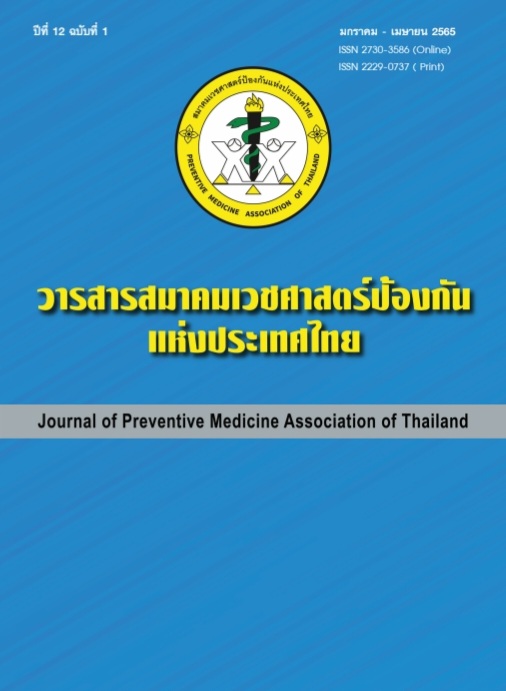Return to Work and Associated Factors of Patients Diagnosed with Stroke in Nopparat Rajathanee Hospital
Keywords:
return to work, ischemic stroke, occupational medicineAbstract
Stroke is one of the public health concerns. Stroke can happen to anyone at any age. The number of stroke patients is increasing all over the world. Returning to work (RTW) is an important indicator of recovery for stroke patients and has a significant impact on subjective well-being and life satisfaction. The aim of this study was to explore the return to work rate and factors affecting return to work in 12-month follow-up stroke patients. The population of the study was 114 stroke patients whose ages ranged from 18 to 60 years old, hospitalized in Nopparat Rajathanee Hospital from January 1, 2018 to December 31, 2018. The study design was a cross-sectional descriptive study. Baseline characteristics, return to work and other factors were collected through medical records and telephone interviews. The data were analyzed by using descriptive and inferential statistics with Fischer’s exact and multiple logistic regression. The results showed that the return to work rate in 12 months was 73.7%. Most of them return to work at day 30. Independency at discharge (in the modified Rankin Scale) and lower NIHSS score (mild stroke and mild to moderate stroke) were significant risk factors for RTW after 1 year with adjusted odds ratio 9.34 (95% CI = 1.91-45.81), 49.35 (95% CI = 22.80-870.42) and 27.72 (95% CI = 1.80-425.76), respectively. Other factors like white collar and higher income increased the probability of return to work when compared with blue collar and lower income respectively but no statistically significant. In conclusion, personal factors, treatment factors and work-related factors were associated with return to work. These factors should be concerned for patient care to return to work. This knowledge can contribute to more individualized vocational rehabilitation.
References
World Stroke Organization: (WSO). Campaign Advocacy Brochures 2017 [Internet]. 2017. [cited 2017 Apr 11]. Available from: http://www.worldstrokecampaign.org/images/wsd-2017/brochures-2017/WSD_brochure_FINAL_sponsor_.pdf
สำนักโรคไม่ติดต่อ กรมควบคุมโรค กระทรวงสาธารณสุข. รายงานประจำปีสำนักโรคไม่ติดต่อ 2560:ประเด็นสารรณรงค์วันอัมพาตโลก ปี 2560. นนทบุรี: กระทรวงสาธารณสุข; 2561.
วิวัฒน์ เอกบูรณะวัฒน์. การดูแลผู้ป่วยกลับเข้าทำงาน. ชลบุรี: สัมมาอาชีวะ; 2554. หน้า 1, 12.
Canadian Medical Association (CMA). The physician’s role in helping patients return to work after an illness or injury (update 2000) [Internet]. 2000 [cited 2017 Apr 11]. Available from: https://www.wcb.ns.ca/Portals/wcb/Publications/Physicians_Role_in_RTW.pdf
Glader EL, Jonsson B, Norrving B, Eriksson M. Socionomic factors’ effect on return to work after first stroke. Acta Neural Scand 2017;135(6):608-13.
Coding and classification standards [Internet]. Ireland: Eurofound; 2000 (Updated 2010 Dec 23). [cited 2017 Apr 11]. Available from: https://www.eurofound.europa.eu/surveys/ ewcs/2005/classification
สาคร สมเสริฐ. อัตลักษณ์ของมนุษย์เงินเดือน : เปรียบเทียบคนทำงานคอปกขาวกับคนทำงานคอปกน้ำเงินของบริษัทผลิตอาหารแห่งหนึ่งในเขตเมือง. Veridian E-Journal, SU (กลุ่มมนุษยศาสตร์และสังคมศาสตร์) 2555;5(2):690-706.
Brott T, Adams HP Jr, Olinger CP, Marler JR, Barsan WG, Biller J, et al. Measurements of acute cerebral infarction: a clinical examination scale. Stroke 1989;20(7):864-70.
Broderick JP, Adeoye O, Elm J. Evolution of the modified rankin scale and its use in future stroke trials. Stroke 2017;48:2007-12.
Aarnio K, Rodriguez-Pardo J, Sieggerink B. Return to work after ischemic stroke in young adults : a registry-based follow-up study. Neurology 2018;91(20):e1909-e1917.
Edwards JD, Kapoor A, Linkewich E, Swartz RH. Return to work after young stroke: a systematic review. Int J stroke 2018;13:243-56.
Treger I, Shames J, Giaquinto S, Ring H. Return to work in stroke patients. Disabil Rehabil 2007;29:1397-403.
Satirapanya C, Sathiranya P, TraiChan C. Prevalence of Risk Factors for Stroke and Depression after Stroke in Phatthalung Province: cross-sectional study. Songkhla Nakarin Vejsarn Journal 2014;32:275-82.
Westerlind E, Persson HC, Sunnerhagen KS. Return to work after stroke in working age person; a six-year follow up. PLoS One 2017;12(1):e0169759
Maaijwee NA, Rutten-Jacobs LC, Arntz RM, Schaapsmeerders P, Schoonderwaldt HC, van Dijk EJ, et al. Long-term increased risk of unemployment after young stroke: a long-term follow-up study. Neurology 2014;83:1132-8.
Saeki S, Ogata H, Okubo T, Takahashi K, Hoshuyama T. Return to work after stroke: a follow-up study. Stroke 1995;26:399-401.
Downloads
Published
How to Cite
Issue
Section
License
Copyright (c) 2022 Journal of Preventive Medicine Association of Thailand

This work is licensed under a Creative Commons Attribution-NonCommercial-NoDerivatives 4.0 International License.
บทความที่ลงพิมพ์ในวารสารเวชศาสตร์ป้องกันแห่งประเทศไทย ถือเป็นผลงานวิชาการ งานวิจัย วิเคราะห์ วิจารณ์ เป็นความเห็นส่วนตัวของผู้นิพนธ์ กองบรรณาธิการไม่จำเป็นต้องเห็นด้วยเสมอไปและผู้นิพนธ์จะต้องรับผิดชอบต่อบทความของตนเอง






